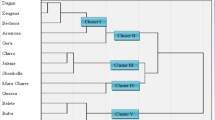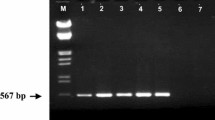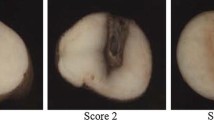Abstract
Bacterial soft rot caused by Erwinia carotovora subsp. carotovora is a major disease in Zantedeschia spp., particularly in cultivars from the section Aestivae. The disease can be partly controlled by cultural measures, but by combining cultural methods with resistant plant material a promising strategy for control of soft rot can be developed. No tests are available for resistance testing in breeding Zantedeschia spp. Therefore, three tests developed for use in potato breeding were adapted for use on eight cultivars of Zantedeschia spp. Variation was found in all three tests. Resistant control cultivar Zantedeschia aethiopica ‘Crowborough’ scored most resistant in all three tests. Within the section Aestivae, degrees of susceptibility were identified that were in agreement with each other and with field observations, indicating reliability of two of the methods in which tubers were used. The correlation coefficient of these two tests was high. A new non-destructive test method was developed for use on seedlings which involved immersion of leaf disks in a bacterial suspension. The percentage of decayed leaf area was a measure of resistance and results were in general agreement with the other tests. These methods will be useful for breeding for soft rot resistance and performing genetic analyses.
Similar content being viewed by others
References
Allefs J, Van Dooijeweert W, Delfosse Ph, French E, Gutarra de Lindo L and Pérombelon M (1993) A standardised method for screening of potato tubers for resistance to Erwinia carotovora subsp. atroseptica. In: Rousselle-Bourgeois F, Andrivon D, Aurousseau-Larrue F, Bonnel E, Crouau G, Ellissèche D, Gravoueille JM, Hervé A, Van Kempen P, Kerlan C, Le Hingrat Y, Mugniery D, Robert Y and Rossignol L (eds) Abstracts of 12th Triennial Conference of the European Association of Potato Research (pp 311–312) INRA, France
Allefs JJHM, Van Dooijeweert W, De Jong ER, Prummel W and Hoogendoorn J (1995) Factors affecting potato soft-rot resistance to pectolytic Erwinia species in a tuber-slice assay. Journal of Phytopathology 143: 705–711
Allefs JJHM, Van Dooijeweert W, Prummel W, Keizer LCP and Hoogendoorn J (1996) Components of partial resistance to potato blackleg caused by pectolytic Erwinia carotovora subsp. atroseptica and E. chrysanthemi. Plant Pathology 45: 486–496
Bain RA and Pérombelon MCM (1988) Methods of testing potato cultivars for resistance to soft rot of tubers caused by Erwinia carotovora subsp. atroseptica. Plant Pathology 37: 431–437
Bisht VS, Bains PS, and Letal JR (1993) A simple and efficient method to assess susceptibility of potato to stem rot by to Erwinia carotovora subspecies. American Potato Journal 70: 611–616
Blom TJ and Brown W (1999) Preplant copper-based compounds reduce Erwinia soft rot on calla lilies. HortTechnology 9: 56–59
Brown J (1988) California calla breeding. Herbertia 46: 165–169
Carputo D, Speggiorin M, Gareffa P, Raio A and Monti LM (1996) Screening for resistance to tuber soft rot and blackleg in diploid Solanum species and S. tuberosum haploids. Journal of Genetics and Breeding 50: 221–226
Corr BE (1993) Zantedeschia research in the United States, past present and future. Acta Horticulturea 337: 177–187
Darling D, Harling R, Simpson A, McRoberts N and Hunter EA (2000) Susceptibility of broccoli cultivars to bacterial head rot: in vitro screening and the role of head morphology in resistance. European Journal of Plant Pathology 106: 11–17
Engel B and Keen A (1994) A simple approach for the analysis of generalized linear mixed models. Statistica Neerlandica 48: 1–22
Funnell KA (1993) Zantedeschia. In: De Hertogh A and Le Nard M (eds) The Physiology of Flower Bulbs (pp 683–704) Elsevier, Amsterdam
Funnell KA and MacKay BR (1999) Directions and challenges of the New Zealand calla industry, and the use of calcium to control soft rot. In: Sheen T-F, Chen J-J, Yang T-C and Liu M-C (eds) The International Symposium on Development of Bulbous Flower Industry (pp 30–44) TSIPS, Taiwan
Genstat 5 Committee (1993) Genstat 5 Reference Manual, Version 3, Clarendon, Oxford
Haynes KG, Potts WJE and Goth RW (1997) Evaluation of the reliability of determining soft rot resistance in potatoes by the tuber slice method. American Potato Journal 74: 265–275
Hélias V, Andrivon D and Jouan B (2000) Development of symptoms caused by Erwinia carotovora ssp. atroseptica under field conditions and their effects on the yield of individual potato plants. Plant Pathology 49: 23–32
Keen A and Engel B (1998) Procedure IRREML. In: Goedhart PW and Thissen JTNM (eds) CBW Procedure Library Manual. Release 4.1 (pp 35–39) CPRO-DLO, Wageningen
Kuehny JS (2000) Calla history and culture. HortTechnology 10: 267–274
Letty C (1973) The genus Zantedeschia. Bothalia 11(1&2): 5–26
Lojkowska E and Kelman A (1994) Comparison of the effectiveness of different methods of screening for bacterial soft rot resistance of potato tubers. American Potato Journal 71: 99–113
Mukherjee A, Cui Y, Ma W, Lui Y and Chatterjee AK (2000) hexA of Erwinia carotovora ssp. carotovora strain Ecc71 negatively regulates production of RpoS and rsmB RNA, a global regulator of extracellular proteins, plant virulence and the quorum sensing signal, N-(3-oxohexanoyl-L-homoserine lactone. Environmental Microbiology 2: 203–215
Pagel W and Heitefuss R (1989) Calcium content and cell wall polygalacturonans in potato tubers of cultivars with different susceptibilities to Erwinia carotovora subsp. atroseptica. Physiological and Molecular Plant Pathology 35: 11–21
Pérombelon MCM and Kelman A (1980) Ecology of the soft rot Erwinias. Annual Review of Phytopathology 18: 361–387
Pérombelon MCM and Salmond GPC (1995) Bacterial soft rots. In: Singh US, Singh RP and Kohmoto K (eds) Pathogenesis and Host Specificity in Plant Diseases. Vol. 1 (pp 1–20) Pergamon, Oxford
Ren J, Petzoldt R and Dickson MH (2001) Screening and identification of resistance to bacterial soft rot in Brassica rapa. Euphytica 118: 271–280
Robinson A, Clark CJ and Clemens J (2000) Using 1H magnetic resonance imaging and complementary analytical techniques to characterize developmental changes in the Zantedeschia Spreng. tuber. Journal of Experimental Botany 51: 2009–2020
Schober BM and Vermeulen T (1999) Enzymatic maceration of witloof chicory by the soft rot bacteria Erwinia carotovora subsp. carotovora: the effect of nitrogen and calcium treatments of the plant on pectic enzyme production and disease development. European Journal of Plant Pathology 105: 341–349
Shibuya R (1956) Intercrossing Among Pink Calla, White-spotted Calla and Yellow Calla. Kasai, Tokyo
Singh Y, Van Wyk AE and Baijnath H (1996) Taxonomic notes on the genus Zantedeschia Spreng. (Araceae) in southern Africa. South African Journal of Botany 62: 321–324
Wright P (1998) A soft rot of calla (Zantedeschia spp.) caused by Erwinia carotovora subsp. carotovora. New Zealand Journal of Crop and Horticultural Science 26: 331–334
Wright PJ and Burge GK (2000) Irrigation, sawdust mulch, and Enhance (R) biocide affects soft rot incidence, and flower and tuber production of calla. New Zealand Journal of Crop and Horticultural Science 28: 225–231
Yao JL, Cohen D and Rowland RE (1994) Plastid inheritance and plastome-genome incompatibility in interspecific hybrids of Zantedeschia (Araceae). Theoretical and Applied Genetics 88: 255–260
Yao JL, Cohen D and Rowland RE (1995) Interspecific albino and variegated hybrids in the genus Zantedeschia. Plant Science 109: 199–206
Author information
Authors and Affiliations
Rights and permissions
About this article
Cite this article
Snijder, R.C., van Tuyl, J.M. Evaluation Of Tests to Determine Resistance of Zantedeschia spp. (Araceae) to Soft Rot caused by Erwinia carotovora subsp. carotovora . European Journal of Plant Pathology 108, 565–571 (2002). https://doi.org/10.1023/A:1019973219999
Issue Date:
DOI: https://doi.org/10.1023/A:1019973219999




